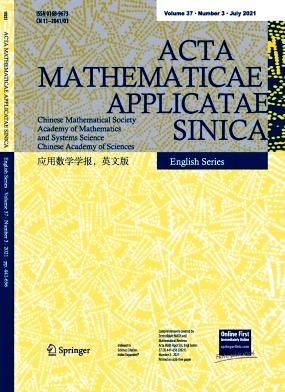Multicolored Bipartite Ramsey Numbers of Large Cycles
IF 0.9
4区 数学
Q3 MATHEMATICS, APPLIED
Acta Mathematicae Applicatae Sinica, English Series
Pub Date : 2023-12-29
DOI:10.1007/s10255-024-1118-3
引用次数: 0
Abstract
For an integer r ≥ 2 and bipartite graphs Hi, where 1≤ i ≤ r the bipartite Ramsey number br(H1, H2, …, Hr) is the minimum integer N such that any r-edge coloring of the complete bipartite graph KN,N contains a monochromatic subgraph isomorphic to Hi in color i for some 1 ≤ i ≤ r. We show that if \(r \ge 3,{\alpha _1},{\alpha _2} > 0,{\alpha _{j + 2}} \ge [(j + 2)! - 1]\sum\limits_{i = 1}^{j + 1} {{\alpha _i}} \) for j = 1, 2, …, r −2, then \(br({C_{2\left\lfloor {{\alpha _1}\,n} \right\rfloor }},{C_{2\left\lfloor {{\alpha _2}\,n} \right\rfloor }}, \cdots ,{C_{2\left\lfloor {{\alpha _r}\,n} \right\rfloor }}) = (\sum\limits_{j = 1}^r {{\alpha _j} + o(1))n} \).
大循环的多色二方拉姆齐数
对于整数 r ≥ 2 和双元图 Hi,其中 1≤ i ≤ r 的双元拉姆齐数 br(H1,H2,...,Hr)是最小整数 N,使得完整双元图 KN,N 的任何 r 边着色都包含一个在颜色 i 中与 Hi 同构的单色子图,对于某个 1≤ i ≤ r。我们证明如果 \(r \ge 3,{\alpha _1},{\alpha _2} > 0,{\alpha _{j + 2}}\(j + 2)! - 1](sum/limits_{i = 1}^{j + 1}{{α _i}}\) for j = 1, 2, ..., r -2, then \(br({C_{2\left\lfloor {{\alpha _1}\,n}\right\rfloor }},{C_{2left\lfloor {{\alpha _2}\,n}\cdots ,{C_{2\left\lfloor {{\alpha _r}\,n}\right\rfloor }}) = (\sum\limits_{j = 1}^r {{\alpha _j}+ o(1))n}\).
本文章由计算机程序翻译,如有差异,请以英文原文为准。
求助全文
约1分钟内获得全文
求助全文
来源期刊
CiteScore
1.30
自引率
0.00%
发文量
70
审稿时长
3.0 months
期刊介绍:
Acta Mathematicae Applicatae Sinica (English Series) is a quarterly journal established by the Chinese Mathematical Society. The journal publishes high quality research papers from all branches of applied mathematics, and particularly welcomes those from partial differential equations, computational mathematics, applied probability, mathematical finance, statistics, dynamical systems, optimization and management science.

 求助内容:
求助内容: 应助结果提醒方式:
应助结果提醒方式:


